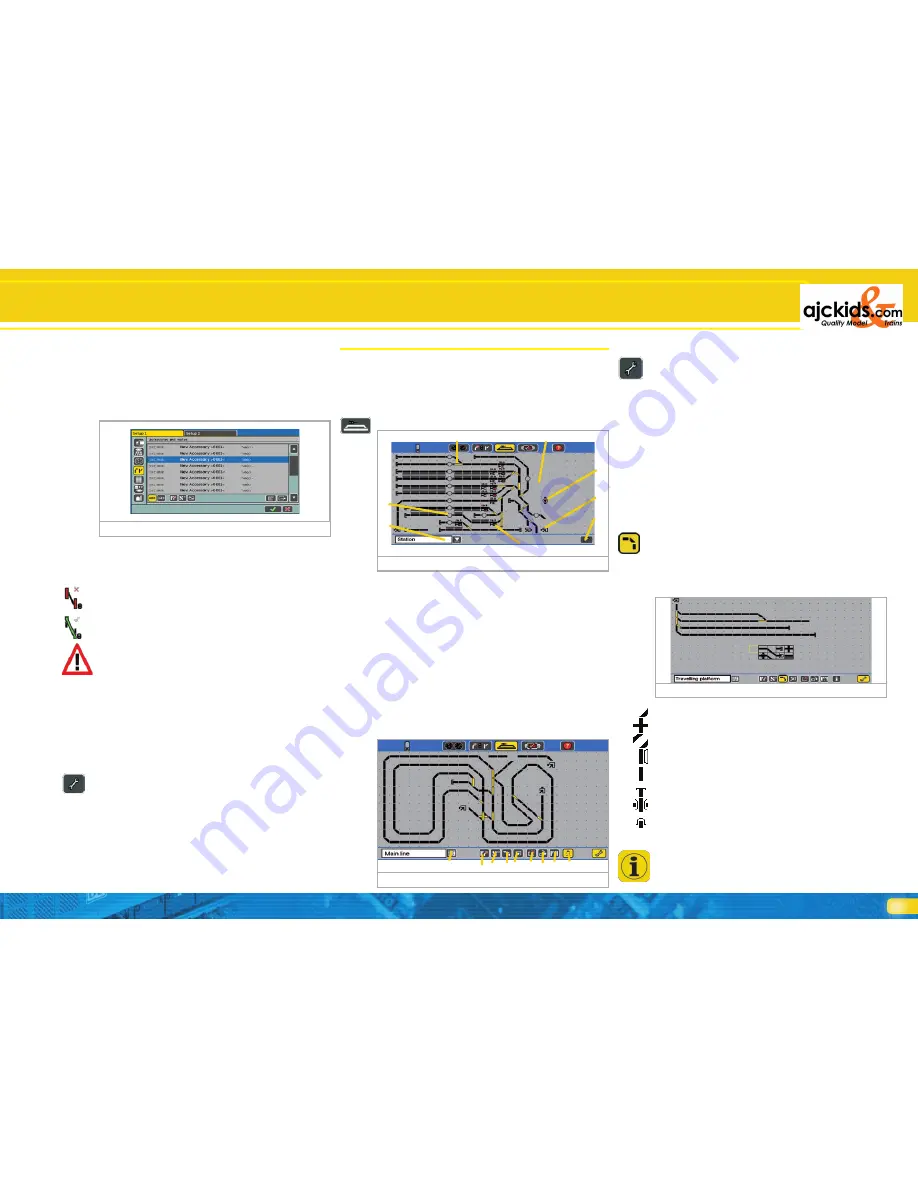
27
15.3. Create a link to a route in the turnout control panel
You can create a link to the same route on several panels of
the turnout control panel. Thus you can better organise your
turnout control panel.
Linking routes happens in the same way as linking accessories.
Chapter 13.3 explains how. Routes are marked with „FW” be-
hind the name in the accessory library.
15.4. Switching a route
In principle a route is switched in the same way as an individual
accessory as described in chapter 13.4. However, there are two
differences:
This pictogram indicates that the route is currently not comple-
ted. At least one accessory did not switch as it was supposed
to.
The route is completed; all accessories are switched to the desi-
red status.
Routes can only be switched. Switching another route that
contains at least one accessory of the previous route does re-
leasing routes.
It is always possible to switch an accessory belonging to a rou-
te individually, for instance through another link to a screen
button in a control panel. As soon as the status of at least one
accessory does not correspond to the appropriate status of this
route the displayed symbol changes. Thus you keep control at
any time and have certainty that all accessories of one route are
switched correctly.
15.5. Deleting a route
Deleting a route is just as simple as deleting an accessory:
• Call up the turnout control panel and go into the configuration
mode.
• Select this symbol. Frames around all accessories and routes
will appear.
• Select the desired route and confirm your choice.
Figure 72
16. Track diagram switching panel
With software version 3.0.0. an important feature has been
added. By “drawing” a track diagram on the screen you can
represent the topology of your layout graphically. You can
switch any turnouts or signals simply by touching the appro-
priate symbol.
16.1. Configuring the track diagram
First call up the track diagram.
a) Area for placing track diagram elements (23 x 11 elements)
b) Display of reference to other panels
c) Display of a route, not set
d) Select another panel
e) Representation of a signal
f) toggling between switching mode and configuration mode
or vice versa
g) Display of a set route
h) Representation of a turnout
• In the
display mode
you can switch all signals, turnouts and
routes directly.
• In the
configuration mode
you can modify the design of the
track diagram.
b)
d)
Figure 74
c)
e)
a)
f) g) h) i)
With this screen button you can toggle between these two
modes. After pressing this button the display changes.
a) Name of the track diagram panel you are working on
b) Add an accessory
c) Add a route
d) Add track symbols
e) Add references to other panels
f) Delete the symbol
g) Turn the symbol
h) Mirror a turnout
i) Information field
The procedure of inserting symbols is always the same regard-
less whether it is a track symbol, an accessory or a route.
16.1.1. Inserting track symbols
Track symbols solely serve to represent the track arrangement
and are purely passive elements.
• Select the screen button “Insert a track symbol”
• Click onto the desired position on the track diagram where you
want to place the new track symbol.
• A window showing all available symbols opens. Select the desi-
red symbol and turn it to the desired direction if necessary.
Curved track
Crossing (diamonds)
Parallel curved track
Platform track
Straight track
Buffer stop
Bridge / overpass
Tunnel
16.1.2. Insert an accessory
Any accessory that you want to insert on the track diagram
must first be entered into the data base and configured. This is
done in the turnout control panels as described in chapter 13.
In the track diagram one cannot enter new accessories.
Figure 75
Track Diagram Switching Panel
b)
e)
Figure 73
d)
f)
a)
h)
c)
g)






























